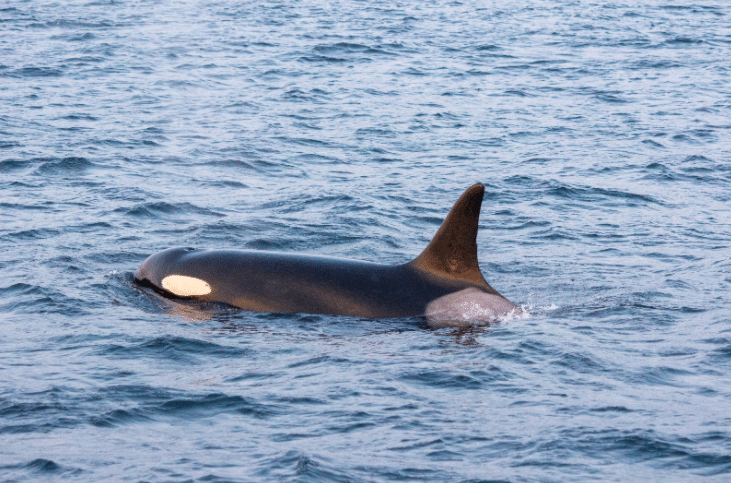Originally posted: May 2015
Many Killer Whales have become famous over their lifetime. Some for heroic acts, others for entertainment, some for sad stories of their capture and life in captivity. In this post, we look at 7 Famous Killer Whales that have stolen our hearts over the years.
Tahlequah
Tahlequah, officially named J35, was born in 1998 and is a part of the J-Pod of the Southern Resident Killer Whales. Tahlequah became famous after her long display of grief at the loss of her newborn calf in the summer of 2018. This became known as the “Tour of Grief” in the media. She carried her dead calf on her head for over 1,000 miles, over 17 days. Tahlequah’s period of grieving is the longest ever witnessed for an orca.
Tahlequah has also given birth to two other calves, both male. The first, Notch (J-47) was born in 2010. This past summer, in 2020, she also gave birth to Phoenix (J-57). We hope that the birth of this new calf brings a new beginning to Tahlequah and the rest of the Southern Resident Killer Whale population.
Granny
Granny, officially named J-2, is famous around the world because she is the oldest known orca and the oldest member of the Southern Resident Killer Whales. It is estimated that Granny was born around 1911 and she passed in 2016. This puts her age at 105 years old!
We can only imagine the changes that Granny witnessed in the Salish Sea and the killer whale population. She was born at a time when humans feared killer whales and often hunted or captured them for aquariums.
Granny was the ultimate matriarch that led the Southern Resident Killer Whales through the Salish Sea for many decades. Her longevity brings joy and has helped the whale research community learn more about orcas. She was often seen leading the J-pod and teaching the young and old where to find food.
Granny was famous across the world and she was a part of our family. For many years Orca Spirit naturalists watched as Granny led her family with wisdom and when she passed, we mourned the loss of a family member. She was a beautiful and well-respected whale, and her story will forever recall fond memories for the team at Orca Spirit.
Keiko
Keiko, the star of the popular Free Willy movie franchise, was born in 1976. Keiko was in captivity and in poor health for many years before the making of the Free Willy movies. After he stole the world’s heart in these movies, much fuss was made of the situation and a lot of money was gathered together to help return him to health and possibly to the wild.
Over 7 million dollars was raised for the procedure and Keiko underwent training to prepare him to be released back into the sea. Keiko took part in supervised swims in the open ocean but in 2002 his trainers lost track of him off Iceland. Keiko was finally spotted 870 miles off the coast of Norway. He then followed a fishing boat to Hasla and was then enticed to Taknesineraction with humans.
At the age of 27 on December 12, 2003 Keiko died of pneumonia. A service was held and attended by some 700 people.
Old Tom

Old Tom was born in 1895 and patrolled the South East coast of Australia. He was a large Killer Whale, measuring 22 feet long and weighing over 6 tons.
Old Tom was believed to be the leader of an Orca pod that helped a group of whalers by herding whales in Twofold Bay. Tom’s pod would help herd the whales and in return for their help they would receive the tongues and lips of the baleen whales to eat.
Old Tom died in 1930 and his preserved skeleton is now on display in the Eden Killer Whale Museum.
Lolita

Lolita, originally known as Tokitae, is the oldest known Orca living in captivity. Lolita is an astonishing 22 feet long and weighs over 8,000 pounds. The capture of Lolita in 1970 has been widely documented as an inhumane and brutal act.
Lolita’s family was spotted in Possession Sound. Men awaiting with speedboats and explosives were notified of their location and the hunt was on. Nearly 80 orcas were originally rounded up during the operation while four juveniles and one female adult were killed.
The five dead whales were slit open and filled with rocks, tails weighed down with anchors and chains in an effort to conceal the deaths from the public. Then, three months later three of the dead Orcas beached on Whidbey Island and their story became public.
Seven of Lolita’s family members were captured, forced into slings, and driven to trucks waiting onshore. They would be distributed to aquariums around the world. Lolita has lived in Miami Seaquarium in Florida ever since. A film named Lolita: Slave to Entertainment documents the cruel and unusual life of Lolita.
Luna

Luna, officially named L98 and also known as Tsuux-iit, was born in 1999 in Puget Sound. Luna was separated from his mother as a toddler and spent five years alone in Nootka Sound, off the west coast of Vancouver Island. He became a major tourist attraction and began to engage boats.
Luna created years of controversy as groups argued over the humane way to treat his situation. Some thought he should be returned to his family and others thought that he should be left alone entirely.
Luna caused major damage to some vessels and a floatplane and received minor injuries himself from collisions with boats.
Some boaters were fined for disturbing the whale. In 2004 Fisheries and Oceans Canada began to try to lure Luna into a floating pen. The Mowachaht/Muchalaht First Nation was opposed to this and successfully lured Luna away from the pen. After 9 days Fisheries and Oceans Canada finally gave up.
On March 10, 2006, Luna was killed when he was hit by the propeller of the ocean tugboat General Jackson. Luna: Spirit of the Whale tells a story based on Luna’s experiences.
Springer

Springer, officially named A73, was born in late 1999 or early 2000. Springer became famous in 2002 when she was discovered alone in Puget Sound, Washington after her mother died.
Six months later, after being treated medically and given food, she was transported to Johnstone Strait, British Columbia, and released near her close relatives. This marked the only time in history that a whale has ever been successfully reintegrated into a wild pod after human intervention.
Springer has now successfully given birth to two calves. The first, named Spirit (A104), was born in 2013 and the second, Storm (A116) was born in 2017. The sexes of her calves are currently unknown according to the Wild Killer Whale Adoption Program.
These 7 Famous Killer Whales have affected the lives of humans everywhere. At Orca Spirit, we strive to provide wildly authentic whale and wildlife experiences for all our guests. We cherish the wildlife in the Salish Sea and don’t disturb or disrupt these amazing creatures in the way that some of these famous killer whales have been. We believe that whales are sacred and wonderful creatures that do not deserve to become famous for some of the ways that the 7 Famous Killer Whales mentioned in this article have been treated by our society.









